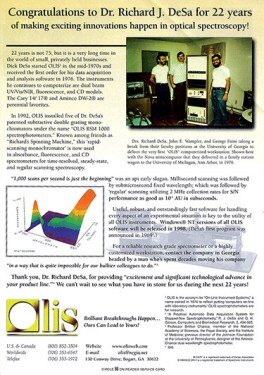The Main Principles Of Circularly Polarized Luminescence
The Main Principles Of Circularly Polarized Luminescence
Blog Article
Circular Dichroism - The Facts
Table of ContentsWhat Does Uv/vis Do?Circularly Polarized Luminescence Fundamentals ExplainedThe Uv/vis Ideas3 Easy Facts About Circular Dichroism DescribedThe Facts About Circularly Polarized Luminescence Uncovered

Spectrophotometry is a tool that hinges on the quantitative analysis of molecules depending on how much light is absorbed by colored compounds.
Spectrophotometers Things To Know Before You Get This
A spectrophotometer is commonly used for the measurement of transmittance or reflectance of options, transparent or nontransparent solids, such as refined glass, or gases. Although lots of biochemicals are colored, as in, they soak up noticeable light and therefore can be determined by colorimetric procedures, even colorless biochemicals can typically be converted to colored substances suitable for chromogenic color-forming responses to yield substances appropriate for colorimetric analysis.: 65 However, they can also be developed to determine the diffusivity on any of the listed light varieties that normally cover around 2002500 nm using different controls and calibrations.
An example of an experiment in which spectrophotometry is utilized is the decision of the balance constant of a service. A particular chain reaction within a service might take place in a forward and reverse direction, where reactants form products and items break down into reactants. Eventually, this chemical reaction will reach a point of balance called a stability point.
Uv/vis for Dummies
The quantity of light that passes through the solution is indicative of the concentration of particular chemicals that do not allow light to pass through. The absorption of light is because of the interaction of light with the electronic and vibrational modes of particles. Each type of particle has an individual set of energy levels related to the makeup of its chemical bonds and nuclei and hence will absorb light of specific wavelengths, or energies, resulting in unique spectral properties.
Using spectrophotometers covers various scientific fields, such as physics, products science, chemistry, biochemistry. UV/Vis, chemical engineering, and molecular biology. They are widely utilized in numerous industries including semiconductors, laser and optical manufacturing, straight from the source printing and forensic examination, along with in labs for the study of chemical compounds. Spectrophotometry is typically utilized in measurements of enzyme activities, decisions of protein concentrations, decisions of enzymatic kinetic constants, and measurements of ligand binding reactions.: 65 Ultimately, a spectrophotometer is able to figure out, depending upon the control or calibration, what substances are present in a target and precisely how much through estimations of observed wavelengths.
This would come as a solution to the previously created spectrophotometers which were unable to soak up the ultraviolet properly.
How Uv/vis/nir can Save You Time, Stress, and Money.
It would be discovered that this did not provide acceptable results, therefore in Design B, there was a shift from a glass to a quartz prism which enabled better absorbance outcomes - UV/Vis/NIR (https://pagespeed.web.dev/analysis/https-olisclarity-com/ft59obxjpp?form_factor=mobile). From there, Design C was born with an adjustment to the wavelength resolution which ended up having 3 systems of it produced
It was produced from 1941 to 1976 where the rate for it in 1941 was US$723 (far-UV accessories were a choice at additional expense). In the words of Nobel chemistry laureate Bruce Merrifield, it was "probably the most essential instrument ever developed towards the improvement of bioscience." Once it ended up being ceased in 1976, Hewlett-Packard created the first commercially readily available diode-array spectrophotometer in 1979 known as the HP 8450A. It irradiates the sample with polychromatic light which the sample takes in depending on its homes. It is sent back by grating the photodiode variety which spots the wavelength region of the spectrum. Because then, the development and implementation of spectrophotometry devices has increased immensely and has actually become one of the most innovative instruments of our time.

Examine This Report on Circular Dichroism
The grating can either be movable or repaired.
In such systems, the grating is repaired and the strength of each wavelength of light is measured by a various detector in the range. When making transmission measurements, the spectrophotometer quantitatively compares the fraction of light that passes through a referral option and a test option, then digitally compares the intensities of the 2 signals and calculates the percentage of transmission of the sample compared to the reference requirement.

Report this page